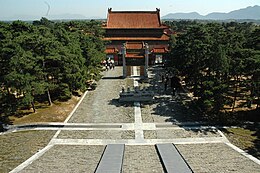| UNESCO World Heritage Site | |
|---|---|
 Yuling, the tomb of the Qianlong Emperor | |
| Location | Zunhua, Hebei, China |
| Part of | Imperial Tombs of the Ming and Qing Dynasties |
| Criteria | Cultural: (i)(ii)(iii)(iv)(vi) |
| Reference | 1004ter-002 |
| Inscription | 2000 (24th Session) |
| Extensions | 2003, 2004 |
| Area | 224 ha (550 acres) |
| Buffer zone | 7,800 ha (19,000 acres) |
| Website | http://www.qingdongling.com/ |
| Coordinates | 40°11′09″N 117°38′49″E / 40.185783°N 117.646923°E |
The Eastern Qing tombs (Chinese: 清東陵; pinyin: Qīng Dōng líng; Manchu: ᡩᡝᡵᡤᡳ
ᡝᡵᡤᡳ
ᠮᡠᠩᡤᠠᠨ, Möllendorff: dergi ergi munggan) are an imperial mausoleum complex of the Qing dynasty located in Zunhua, 125 kilometres (78 mi) northeast of Beijing. They are the largest, most complete, and best preserved extant mausoleum complex in China.[1] Altogether, five emperors (Shunzhi, Kangxi, Qianlong, Xianfeng, and Tongzhi), 15 empresses, 136 imperial concubines, three princes, and two princesses of the Qing dynasty are buried here. Surrounded by Changrui Mountain, Jinxing Mountain, Huanghua Mountain, and Yingfei Daoyang Mountain, the tomb complex stretches over a total area of 80 square kilometres (31 sq mi).
